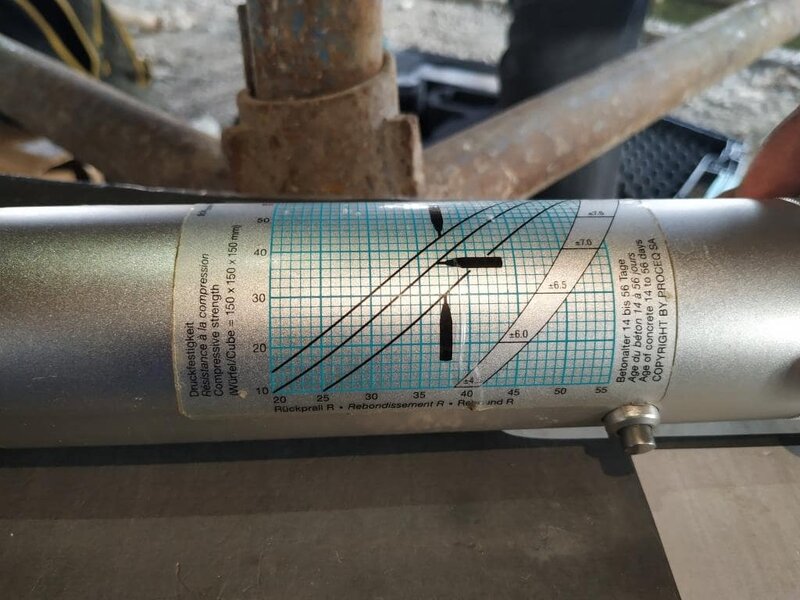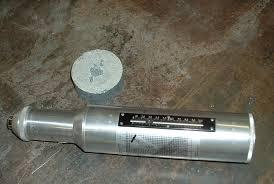A Schmidt hammer, also known as a Swiss hammer or a rebound hammer, is a device to measure the elastic properties or strength of concrete or rock, mainly surface hardness and penetration resistance.
The rebound hammer can provide a fairly accurate estimate of concrete compressive strength. Because it is a nondestructive testing device, it can be used on finished concrete structures, such as precast concrete. However strict procedures must be followed if the test results are to have any validity.
Working Principal
The hammer measures the rebound of a spring-loaded mass impacting against the surface of the sample. The test hammer will hit the concrete at a defined energy. Its rebound is dependent on the hardness of the concrete and is measured by the test equipment. By reference to the conversion chart, the rebound value can be used to determine the compressive strength.

How to take Measurements
12 readings should be taken, dropping the highest and lowest, and then take the average of the ten remaining. Using this method of testing is classed as indirect as it does not give a direct measurement of the strength of the material. It simply gives an indication based on surface properties, it is only suitable for making comparisons between samples.
Some requirements for rebound hammer test
Concrete Age:
The concrete should be 14 to 56 days old. Accurate readings may be possible sooner for a higher strength concrete mix, but 3,500 PSI concrete should not be tested until at least two weeks after pouring
SURFACE CONDITIONS
The surface of the concrete at the point tested must be smooth, dry, and free of honeycombing. Otherwise, rebound readings will be low Indicating a weaker concrete than is actually the case. The rubbing stone provided can be used to grind the surface smooth, if necessary.

LOCATION OF TEST POINTS
The concrete to be tested must be at least four inches thick: It is also recommended that readings be taken only where the concrete has been in contact with the form. Care must be taken that the actual test points are no closer than one inch from another test point.
When conducting the test the hammer should be held at right angles to the surface which in turn should be flat and smooth. The rebound reading will be affected by the orientation of the hammer, when used in a vertical position (on the underside of a suspended slab for example) gravity will increase the rebound distance of the mass and vice versa for a test conducted on a floor slab. The Schmidt hammer is an arbitrary scale ranging from 10 to 100.

How to use Rebound Hammer
Testing Procedure:
Calculate the average of the ten readings. If any single reading differs from the average by more than seven units, discard it and recalculate average using the remaining readings. If more than two readings differ from the average by more than seven units, discard all readings and test again.
Example
Rebound readings = 31, 33, 36, 35, 34, 39, 45, 32, 35 & 33
Average reading = 35.3; discard reaching 45 and recalculate.
Average reading = 34.23
The rebound hammer can provide a fairly accurate estimate of concrete compressive strength. Because it is a nondestructive testing device, it can be used on finished concrete structures, such as precast concrete. However strict procedures must be followed if the test results are to have any validity.
Working Principal
The hammer measures the rebound of a spring-loaded mass impacting against the surface of the sample. The test hammer will hit the concrete at a defined energy. Its rebound is dependent on the hardness of the concrete and is measured by the test equipment. By reference to the conversion chart, the rebound value can be used to determine the compressive strength.

How to take Measurements
12 readings should be taken, dropping the highest and lowest, and then take the average of the ten remaining. Using this method of testing is classed as indirect as it does not give a direct measurement of the strength of the material. It simply gives an indication based on surface properties, it is only suitable for making comparisons between samples.
Some requirements for rebound hammer test
Concrete Age:
The concrete should be 14 to 56 days old. Accurate readings may be possible sooner for a higher strength concrete mix, but 3,500 PSI concrete should not be tested until at least two weeks after pouring
SURFACE CONDITIONS
The surface of the concrete at the point tested must be smooth, dry, and free of honeycombing. Otherwise, rebound readings will be low Indicating a weaker concrete than is actually the case. The rubbing stone provided can be used to grind the surface smooth, if necessary.

LOCATION OF TEST POINTS
The concrete to be tested must be at least four inches thick: It is also recommended that readings be taken only where the concrete has been in contact with the form. Care must be taken that the actual test points are no closer than one inch from another test point.
When conducting the test the hammer should be held at right angles to the surface which in turn should be flat and smooth. The rebound reading will be affected by the orientation of the hammer, when used in a vertical position (on the underside of a suspended slab for example) gravity will increase the rebound distance of the mass and vice versa for a test conducted on a floor slab. The Schmidt hammer is an arbitrary scale ranging from 10 to 100.

How to use Rebound Hammer
Testing Procedure:
- Remove hammer from case and press the plunger end against a hard surface to release the plunger from the locked position. (Do not press lock button while doing this.)
- Position hammer horizontally with plunger end.
- Slowly apply pressure until hammer fires. This will occur when only approximately 1/2 inch of the plunger is still visible. Do not press the lock button during this step.
- With the hammer still pressed, read the rebound number off the scale provided on the hammer. If it is necessary to move the hammer before reading, press the lock button. The rebound number should be read to two significant figures. (e.g., 26, 31, 35)
- Repeat the above procedure at different points until a total of ten readings has been taken.
Calculate the average of the ten readings. If any single reading differs from the average by more than seven units, discard it and recalculate average using the remaining readings. If more than two readings differ from the average by more than seven units, discard all readings and test again.
Example
Rebound readings = 31, 33, 36, 35, 34, 39, 45, 32, 35 & 33
Average reading = 35.3; discard reaching 45 and recalculate.
Average reading = 34.23
